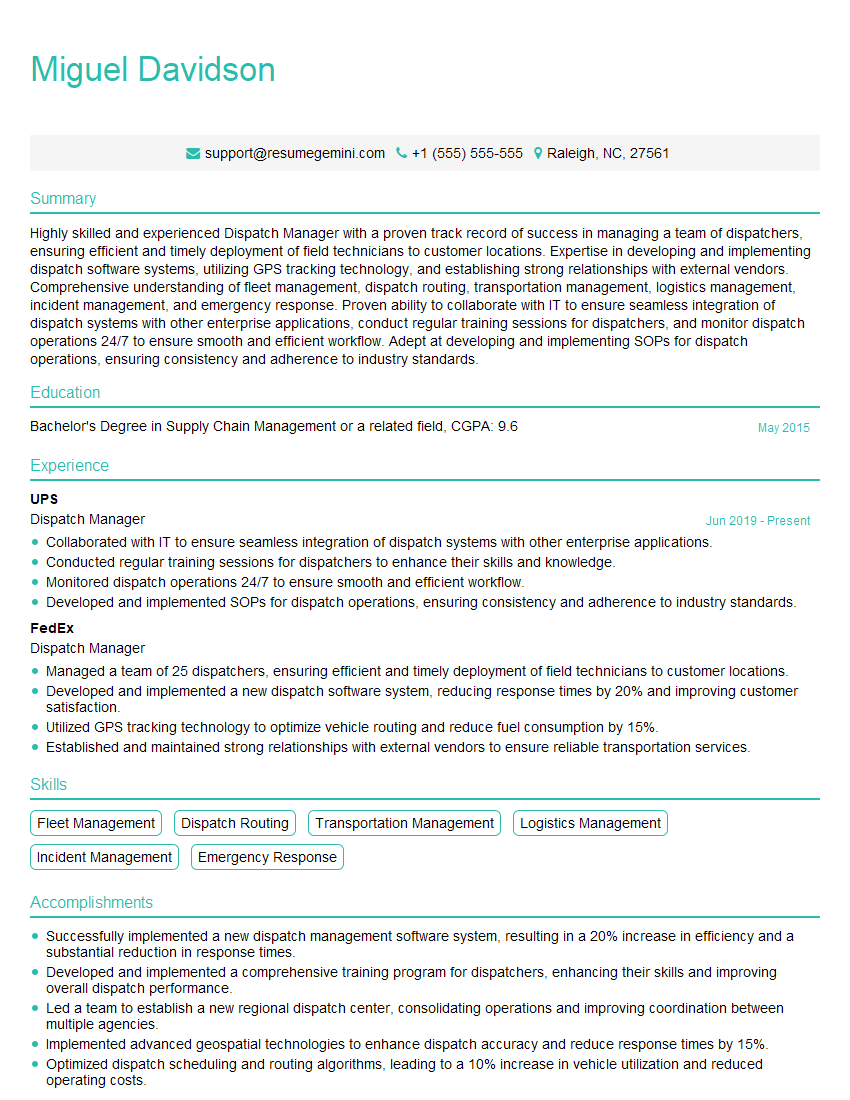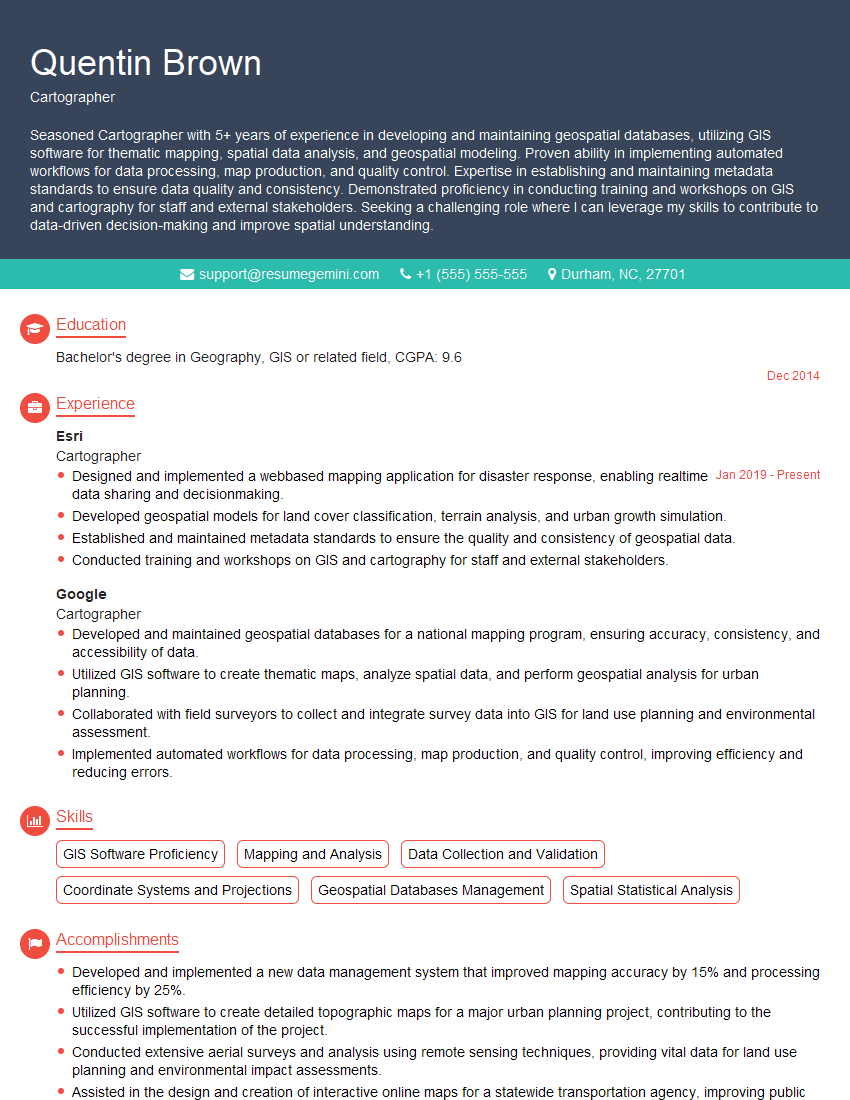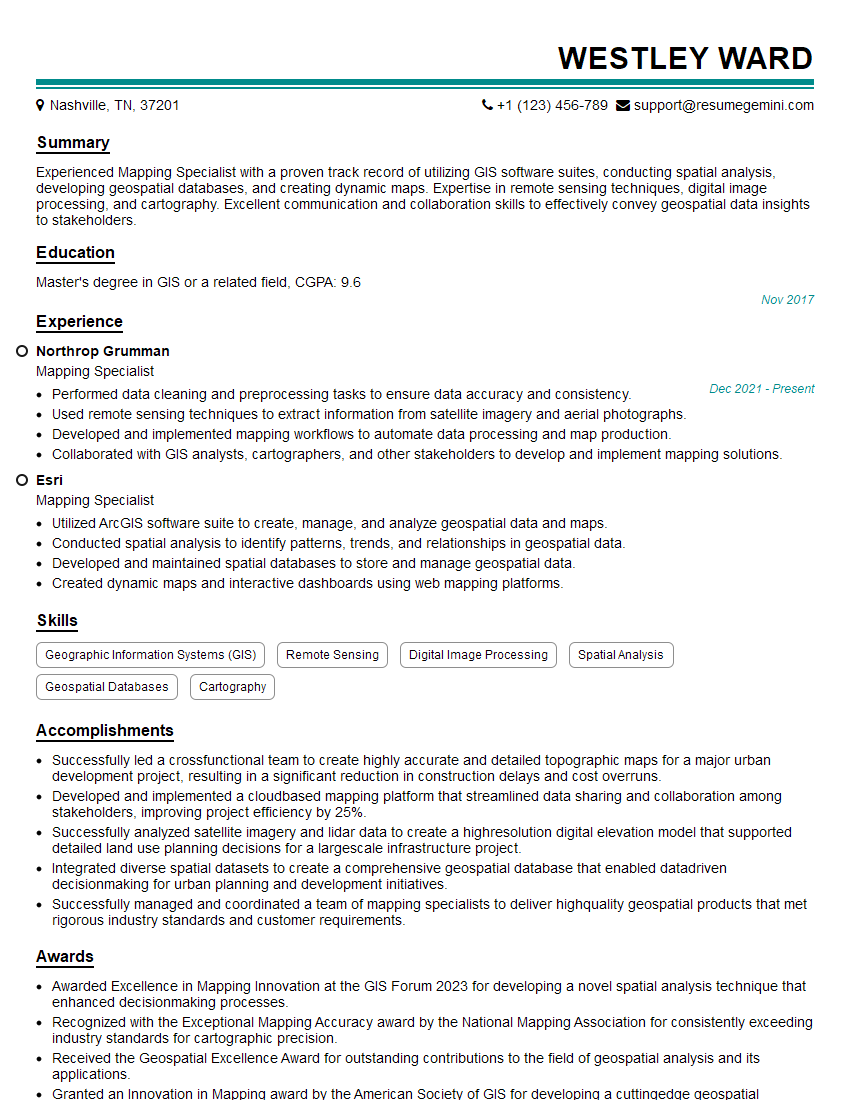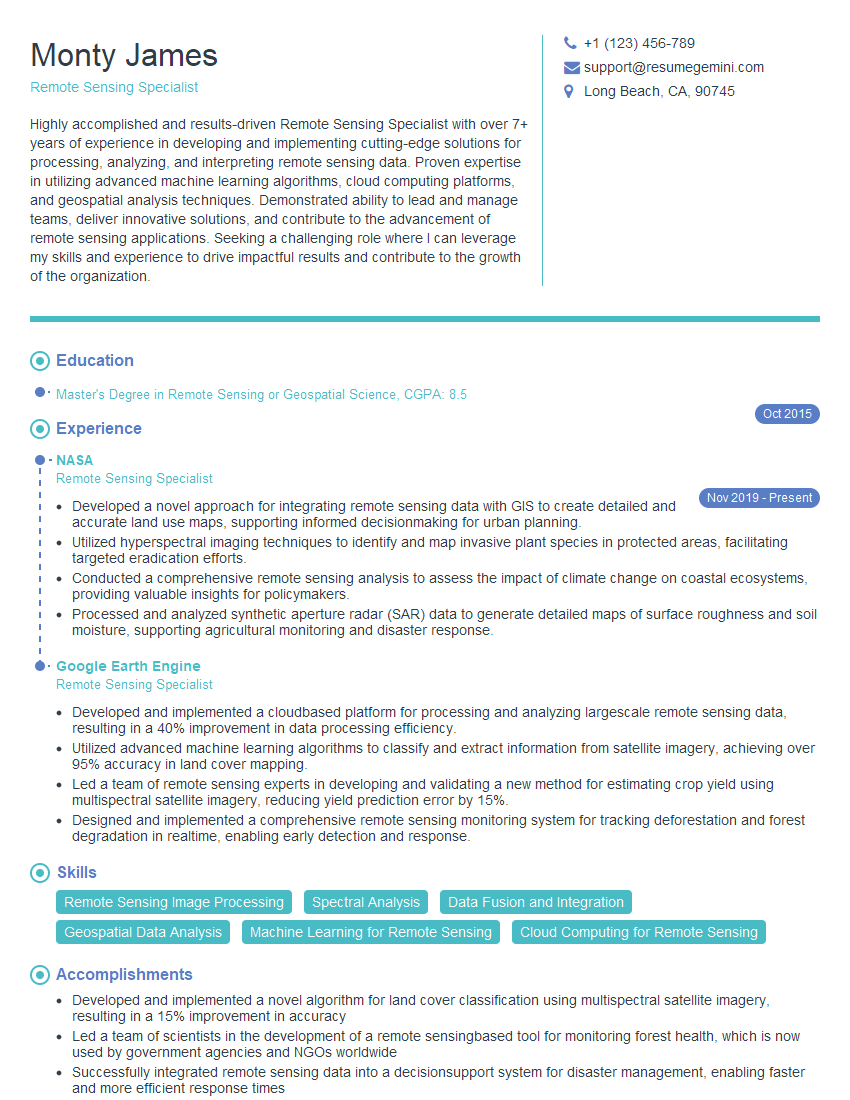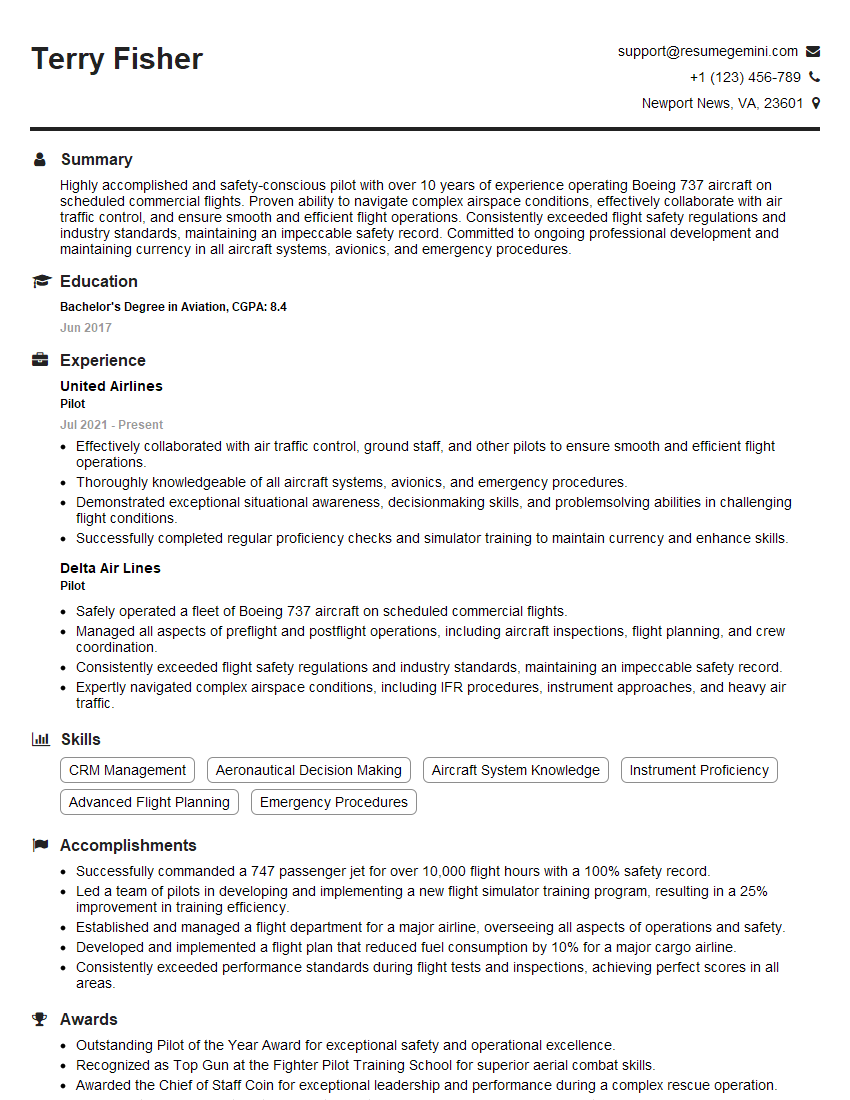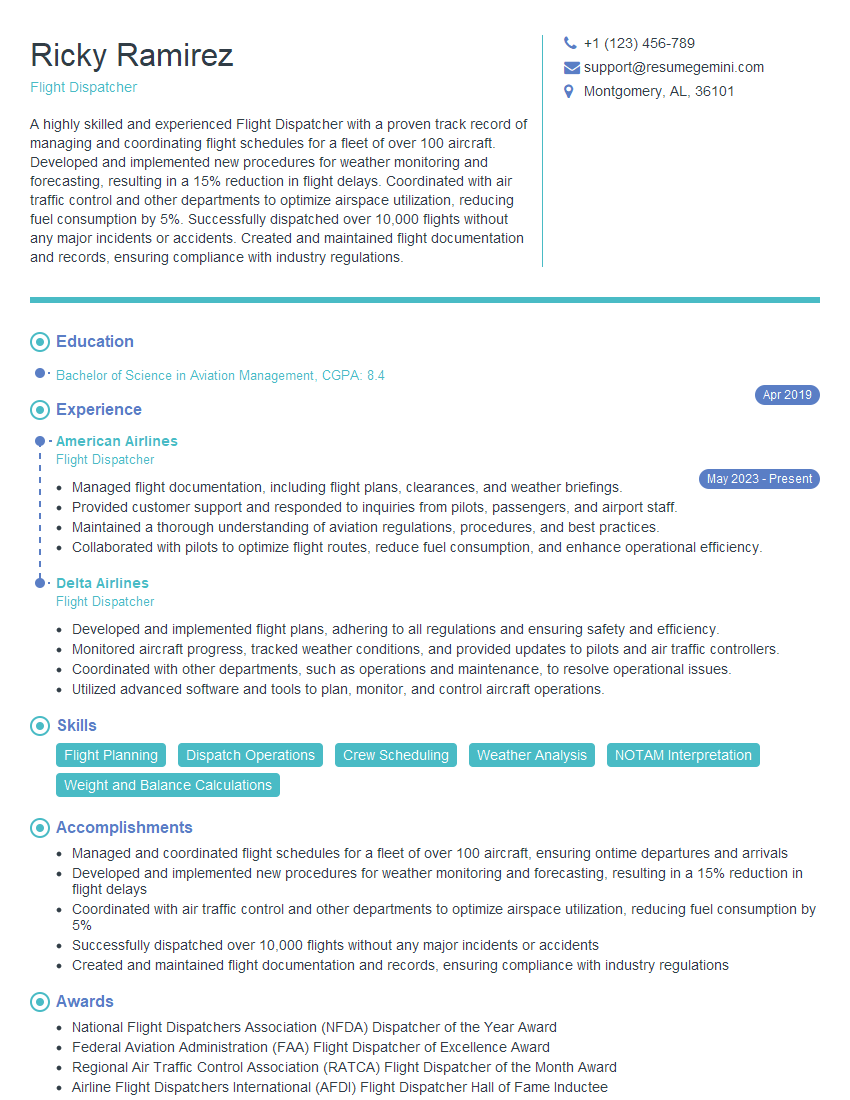The thought of an interview can be nerve-wracking, but the right preparation can make all the difference. Explore this comprehensive guide to GPS and Navigation Skills interview questions and gain the confidence you need to showcase your abilities and secure the role.
Questions Asked in GPS and Navigation Skills Interview
Q 1. Explain the difference between GPS, GLONASS, and Galileo.
GPS, GLONASS, and Galileo are all Global Navigation Satellite Systems (GNSS), providing location and time information to users worldwide. However, they differ in their ownership, satellite constellations, and signal characteristics.
- GPS (Global Positioning System): Developed and operated by the United States Department of Defense, GPS utilizes a constellation of approximately 30 satellites orbiting the Earth. It’s the most widely used GNSS globally.
- GLONASS (Globalnaya Navigatsionnaya Sputnikovaya Sistema): Russia’s counterpart to GPS, GLONASS also employs a constellation of satellites. While less widely used than GPS, it offers significant coverage, particularly in northern latitudes.
- Galileo: The European Union’s GNSS, Galileo aims to provide a highly accurate and independent positioning system. It is designed for civilian use and offers enhanced features such as search and rescue capabilities.
The key differences lie in their signal structures, the accuracy they offer under different conditions, and the level of access provided by their operators. For example, Galileo prioritizes civilian applications and promises high accuracy and availability, distinct from the military origins of GPS.
Q 2. Describe how GPS works, including the role of satellites, receivers, and signals.
GPS works by using a network of satellites to pinpoint a receiver’s location through trilateration. Imagine three circles on a map: each circle represents the distance from a satellite. Where all three circles intersect, that’s your location! Let’s break it down:
- Satellites: These orbiting satellites transmit precise timing signals, including their precise location in space.
- Signals: The signals contain information on the satellite’s position and the time the signal was transmitted. Your receiver picks up these signals from multiple satellites.
- Receivers: Your GPS receiver (in your phone, car, or dedicated device) listens to these signals. By comparing the time the signal was sent with the time it was received, the receiver can calculate the distance to each satellite. Using the distances from at least four satellites (to account for errors), along with precise satellite position data, the receiver computes three-dimensional coordinates (latitude, longitude, and altitude) and time.
In simpler terms, the satellites act like lighthouses, and the GPS receiver uses the signals’ arrival times to figure out its distance from each ‘lighthouse’, thus determining its location on Earth.
Q 3. What are the sources of GPS error, and how can they be mitigated?
GPS accuracy isn’t perfect; several sources introduce errors.
- Atmospheric Effects: The ionosphere and troposphere can delay signals, leading to positional inaccuracies. The ionosphere, a layer of charged particles, affects signal timing, while the troposphere, the lower atmosphere, causes signal refraction.
- Multipath Errors: Signals can bounce off buildings or other objects before reaching the receiver, causing delays and inaccurate distance calculations.
- Satellite Clock Errors: Slight inaccuracies in the atomic clocks aboard the satellites contribute to positional errors.
- Receiver Noise: The receiver itself can introduce noise, affecting the signal reception and calculations.
- Satellite Geometry (GDOP): The geometric arrangement of the satellites visible to the receiver impacts accuracy. Poor geometry can lead to larger positional errors.
Mitigation Techniques: These errors can be mitigated through techniques like:
- Using more satellites: More satellites provide redundancy and improve positional estimates.
- Employing Differential GPS (DGPS): As explained later, this uses a known reference location to correct for errors.
- Implementing advanced signal processing: Sophisticated algorithms within the receiver can reduce the effects of noise and multipath.
- Using augmentation systems: Systems like WAAS/EGNOS enhance GPS signals.
Q 4. Explain the concept of Differential GPS (DGPS).
Differential GPS (DGPS) significantly improves GPS accuracy by using a known reference station with a precisely surveyed location. This station receives the same GPS signals as your receiver. By comparing its known position to its GPS-calculated position, the station identifies the errors present in the GPS signals at that specific location and time. It then transmits these corrections to nearby GPS receivers via radio signals.
Imagine trying to navigate using a slightly inaccurate map. DGPS is like someone telling you, ‘The map is off by 100 meters to the east in this area’ – that correction allows you to get your position much more precisely.
DGPS is especially useful in applications requiring high accuracy, such as surveying, construction, and precision agriculture, where even small errors can lead to significant problems.
Q 5. What is WAAS/EGNOS and how does it improve GPS accuracy?
WAAS (Wide Area Augmentation System) in North America and EGNOS (European Geostationary Navigation Overlay Service) in Europe are satellite-based augmentation systems that improve the accuracy and reliability of GPS signals.
They work by using a network of ground stations to monitor GPS signals and identify errors. These ground stations send correction data to geostationary satellites, which then broadcast the corrections to GPS receivers. These corrections help compensate for atmospheric delays and other errors, resulting in significantly improved accuracy, typically to within a few meters. This is crucial in applications where the precision of GPS is paramount, such as aviation, particularly during approaches and landings.
Think of WAAS/EGNOS as a quality control check for GPS – they refine and validate the data, leading to more dependable positioning.
Q 6. What are some common map projections used in GPS navigation?
Map projections are essential in GPS navigation because they represent the three-dimensional Earth surface on a two-dimensional map. Several projections exist, each with its strengths and weaknesses:
- Mercator Projection: This cylindrical projection preserves direction, making it suitable for navigation but distorting areas, particularly near the poles. The classic world map is often a Mercator projection.
- UTM (Universal Transverse Mercator) Projection: This divides the Earth into zones and uses a transverse Mercator projection within each zone. This reduces distortion and is widely used for large-scale mapping.
- Lambert Conformal Conic Projection: This conic projection minimizes distortion along the chosen standard parallels and is often used for mapping areas spanning significant latitude ranges.
- Equirectangular Projection (Plate Carrée): This simple projection preserves latitude and longitude lines as parallel and perpendicular lines, respectively. While not ideal for navigation over large areas, it’s often used for visualization.
The choice of projection depends on the application’s needs. For example, navigation apps on smartphones often use a combination of projections, dynamically switching based on the area displayed and level of zoom.
Q 7. How do you interpret latitude and longitude coordinates?
Latitude and longitude coordinates specify a point’s location on the Earth’s surface. Latitude measures the distance north or south of the Equator (0°), ranging from -90° (South Pole) to +90° (North Pole). Longitude measures the distance east or west of the Prime Meridian (0°), ranging from -180° to +180°.
For example, the coordinates 34.0522° N, 118.2437° W represent a location approximately 34 degrees north of the Equator and 118 degrees west of the Prime Meridian. This location is near Los Angeles, California.
Understanding latitude and longitude is fundamental in GPS navigation. It is how the GPS receiver communicates its position, and how map applications use this information to display the location and to provide routing information.
Q 8. Explain the concept of geodetic datum.
A geodetic datum is a reference system used to define the precise location of points on the Earth’s surface. Think of it as a foundational framework – a mathematical model of the Earth’s shape and size. It provides a common reference point for all GPS measurements. Without a datum, GPS coordinates would be meaningless, as they’d be relative to different, inconsistent models of the Earth.
Different datums exist because the Earth isn’t a perfect sphere; it’s an oblate spheroid (slightly flattened at the poles and bulging at the equator). Each datum uses slightly different parameters (like the size and shape of the ellipsoid) to best fit a specific region of the Earth. For example, the North American Datum of 1983 (NAD83) is optimized for North America, while the World Geodetic System 1984 (WGS84) is a global datum used by GPS satellites. Using the wrong datum can lead to significant errors in positioning, potentially up to hundreds of meters.
In practice, understanding datums is crucial for ensuring accuracy. When working with map data or GPS coordinates, it’s essential to know which datum is being used to avoid errors in measurements and calculations. Software applications often allow for datum transformation, converting coordinates between different datums to maintain consistency.
Q 9. What are the different types of map data used in GPS navigation?
GPS navigation relies on various types of map data to provide users with contextual information and guidance. These data types can be broadly categorized as:
- Raster Data: This consists of imagery like satellite photos and aerial photographs. Think of it as a picture of the Earth’s surface. It provides visual context but may lack detailed attribute information.
- Vector Data: This represents geographic features as points, lines, and polygons. Roads, buildings, rivers, and points of interest are all represented as vectors. This is useful for navigation as it allows for precise calculations of distances and routes.
- Elevation Data: This provides information on the height of the terrain. This is essential for accurate route planning, especially in mountainous areas, and for applications such as 3D map visualization.
- Attribute Data: This gives detailed information associated with geographic features. For example, the name of a street, the speed limit, or the opening hours of a business. This enriches the user experience by providing relevant details during navigation.
The combination of these data types creates a rich and informative map used for navigation. The quality and detail of the data greatly affect the accuracy and reliability of the navigation system. For instance, using outdated map data may lead to wrong directions or missing important information.
Q 10. Describe various navigation techniques used in different environments (e.g., marine, aviation, land).
Navigation techniques vary significantly based on the environment. Here’s a breakdown:
- Marine Navigation: Involves a combination of GPS, electronic charts (ENCs), radar, and other sensors. Techniques include dead reckoning (estimating position based on speed and course), celestial navigation (using stars), and use of electronic position-indicating radio beacons (such as those from LORAN-C).
- Aviation Navigation: Relies heavily on GPS, inertial navigation systems (INS), VOR (Very high frequency Omnidirectional Range), ILS (Instrument Landing System), and other radio navigation aids. Air traffic control plays a significant role in guiding aircraft. Advanced flight planning software utilizes detailed terrain data and airspace restrictions for safe and efficient flight paths.
- Land Navigation: Employs a range of techniques, from basic map and compass navigation to sophisticated GPS-based systems. Modern car navigation systems often use dynamic route recalculation based on real-time traffic conditions. Other land-based navigation could include the use of waypoints, bearings, and estimated times of arrival.
Each of these environments presents unique challenges. Marine navigation must consider currents and tides, aviation must deal with weather and air traffic, while land navigation needs to account for road closures and traffic congestion.
Q 11. How would you handle a GPS receiver malfunction during navigation?
A GPS receiver malfunction during navigation necessitates a swift and methodical response. First, I’d attempt to troubleshoot the receiver itself – checking for power issues, signal obstruction (e.g., dense foliage, buildings), or software glitches. A simple restart might solve the problem.
If the problem persists, I’d immediately revert to backup navigation methods. This could include:
- Paper maps and compass: A fundamental skill in navigation is knowing how to use traditional tools. This is especially crucial in remote areas or situations with potential communication loss.
- Inertial Navigation System (INS) if available: An INS provides a measure of position and orientation independent of external signals and can be used as a backup.
- Celestial Navigation (if applicable and skills are available): This time-tested method provides positioning using astronomical measurements.
- Contacting emergency services: If the situation is dangerous or the problem can’t be resolved, contacting relevant authorities should be a priority.
The key is preparedness. Always have backup navigation methods and communication strategies planned, especially for critical journeys.
Q 12. Explain the concept of route planning and optimization.
Route planning and optimization involves selecting the most efficient path between two or more points, considering various factors. It’s more than just finding the shortest distance; it’s about finding the best route given constraints like time, distance, fuel consumption, road conditions, and legal restrictions (one-way streets, speed limits).
Route optimization algorithms use various techniques such as:
- Shortest Path Algorithms (e.g., Dijkstra’s algorithm): Find the shortest path considering only distance.
- A* Search Algorithm: A more sophisticated algorithm that considers estimated distance to the destination, making it more efficient for larger networks.
- Traffic Data Integration: Real-time traffic information is incorporated to avoid congestion and minimize travel time.
- Constraint Satisfaction: Algorithms ensure that the route adheres to specified constraints such as avoiding toll roads or specific types of roads.
In practice, sophisticated GPS systems use these optimization techniques to calculate routes. For instance, navigation apps account for traffic in real-time to suggest faster routes, while delivery services use route optimization to schedule efficient delivery plans, optimizing across many points.
Q 13. How would you calculate the distance between two points using GPS coordinates?
Calculating the distance between two points using GPS coordinates involves applying the Haversine formula, which accounts for the Earth’s curvature. This is more accurate than simple Euclidean distance calculations which assume a flat surface. The formula utilizes the latitude and longitude coordinates (in radians) of the two points.
Here’s a simplified representation (actual implementation often requires libraries for handling trigonometric functions and unit conversions):
//Simplified representation - requires detailed coding for full implementation. Libraries are usually needed. function haversineDistance(lat1, lon1, lat2, lon2) { // Convert degrees to radians lat1 = toRadians(lat1); lon1 = toRadians(lon1); lat2 = toRadians(lat2); lon2 = toRadians(lon2); // Haversine formula const dLat = lat2 - lat1; const dLon = lon2 - lon1; const a = Math.sin(dLat / 2) * Math.sin(dLat / 2) + Math.cos(lat1) * Math.cos(lat2) * Math.sin(dLon / 2) * Math.sin(dLon / 2); const c = 2 * Math.atan2(Math.sqrt(a), Math.sqrt(1 - a)); const distance = EARTH_RADIUS * c; // EARTH_RADIUS in meters return distance; } function toRadians(degrees) { return degrees * Math.PI / 180; } Remember to use the appropriate Earth radius (approximately 6371 kilometers or 3959 miles) depending on the desired units of the output. Most programming languages have libraries that simplify this calculation.
Q 14. What are some common challenges associated with GPS navigation in urban canyons?
Urban canyons, formed by tall buildings, present significant challenges to GPS navigation. The main issue is signal blockage and multipath effects.
- Signal Blockage: Tall buildings obstruct the line-of-sight between the GPS receiver and satellites. This reduces the number of visible satellites, weakening the signal and reducing accuracy. In severe cases, a sufficient number of satellites for accurate positioning may not be visible at all.
- Multipath Effects: GPS signals can bounce off buildings before reaching the receiver. This causes the receiver to detect delayed and distorted signals, leading to inaccurate position estimations. The receiver might calculate a position that is slightly offset from the actual location.
- Atmospheric Effects: While not unique to urban canyons, the urban environment may exacerbate the impact of atmospheric conditions on signal propagation.
To mitigate these challenges, urban navigation systems often employ:
- Augmentation systems: Such as WAAS or EGNOS, which improve accuracy by correcting for errors caused by atmospheric effects.
- Inertial Navigation Systems (INS): These systems can provide short-term position updates, bridging the gaps when GPS signals are weak or unreliable. This is a common tactic in high-precision applications such as autonomous vehicles.
- Map matching techniques: These algorithms compare GPS data with digital maps to improve position accuracy by inferring location based on nearby roads or landmarks.
Ultimately, robust urban navigation requires a combination of techniques to compensate for the limitations of GPS in challenging environments.
Q 15. What are the limitations of GPS in certain environments (e.g., dense forests, underground)?
GPS relies on signals from satellites. Obstacles like dense forests and underground locations severely limit or completely block these signals, rendering GPS inaccurate or unusable.
- Dense Forests: The thick canopy of trees blocks the line-of-sight to the satellites. This leads to signal attenuation (weakening) and multipath errors (signals bouncing off trees before reaching the receiver), resulting in inaccurate position fixes. Imagine trying to pinpoint your location while completely surrounded by tall buildings – the same principle applies.
- Underground: GPS signals cannot penetrate the earth. Underground environments, such as caves or tunnels, lack any satellite visibility, making GPS completely ineffective. Think of it like trying to receive a radio signal inside a Faraday cage.
- Urban Canyons: Tall buildings in cities create similar challenges to dense forests, with signal reflections and blockage leading to reduced accuracy and reliability.
In these environments, alternative navigation techniques like inertial navigation systems (INS), compass, or map and compass skills are crucial.
Career Expert Tips:
- Ace those interviews! Prepare effectively by reviewing the Top 50 Most Common Interview Questions on ResumeGemini.
- Navigate your job search with confidence! Explore a wide range of Career Tips on ResumeGemini. Learn about common challenges and recommendations to overcome them.
- Craft the perfect resume! Master the Art of Resume Writing with ResumeGemini’s guide. Showcase your unique qualifications and achievements effectively.
- Don’t miss out on holiday savings! Build your dream resume with ResumeGemini’s ATS optimized templates.
Q 16. Describe your experience with different GPS mapping software (e.g., ArcGIS, QGIS).
I’ve had extensive experience with both ArcGIS and QGIS, leveraging their strengths for different tasks. ArcGIS, with its powerful geoprocessing tools and extensive online resources, is my go-to for complex spatial analyses and large-scale projects, especially those requiring advanced data management and collaboration. For instance, I used ArcGIS Pro to create a detailed risk assessment map for a landslide-prone region, integrating elevation data, rainfall patterns, and soil type information.
Conversely, QGIS, with its open-source nature and flexibility, is ideal for rapid prototyping, data visualization, and smaller-scale projects. Its plugin ecosystem offers a wide range of functionalities, allowing for customization. I utilized QGIS to quickly process and display GPS tracks from a wildlife tracking project, enabling efficient visualization of animal movement patterns. The open-source aspect also allowed collaboration with colleagues who preferred open-source software.
Q 17. Explain your understanding of GIS data structures and formats.
GIS data structures and formats dictate how spatial data is organized and stored. Understanding these is fundamental to efficient data processing and analysis.
- Vector Data: Represents geographic features as points, lines, and polygons. Shapefiles (
.shp, .shx, .dbf) are a common example. Each feature has attributes associated with it, stored in a database table. Imagine a map showing individual buildings as points, roads as lines, and parks as polygons. - Raster Data: Represents geographic features as a grid of cells or pixels, each with a value. Common formats include GeoTIFF (
.tif) and ERDAS Imagine (.img). Think of a satellite image or a digital elevation model (DEM). - Geodatabases: Are a more advanced data structure provided by Esri’s ArcGIS, offering relational database management capabilities. They allow integration of vector and raster data in a single, well-organized structure.
The choice of data format depends on the type of data and the analysis required. Vector data is suitable for discrete features like buildings, while raster data is better for continuous features like temperature or elevation.
Q 18. How do you ensure data accuracy and integrity in a GPS navigation system?
Ensuring data accuracy and integrity in a GPS navigation system is crucial. A multi-pronged approach is essential:
- Pre-processing: This involves checking the GPS receiver’s health, verifying signal strength and satellite geometry (PDOP – Position Dilution of Precision), and correcting for any known systematic errors (e.g., atmospheric delays).
- Data Validation: Post-processing involves verifying the collected data for outliers and inconsistencies. This might involve checking for improbable speed changes or impossible locations. Software tools can be used to automatically detect and filter these inconsistencies.
- Differential GPS (DGPS) or Real-Time Kinematic (RTK) GPS: These techniques improve accuracy by correcting for errors using reference stations with known positions. DGPS corrects for systematic biases, while RTK provides centimeter-level accuracy. I’ve used RTK GPS successfully in high-precision surveying projects, obtaining incredibly accurate data.
- Data Backup and Version Control: Regularly backing up the GPS data to prevent loss and using version control systems ensure data integrity and auditability.
By combining these methods, one can significantly enhance the reliability and accuracy of the GPS data.
Q 19. Describe your experience with GPS data processing and analysis.
My experience in GPS data processing and analysis encompasses a wide range of techniques. I’m proficient in using software like ArcGIS and QGIS to process raw GPS data, applying various filters and transformations.
- Data Cleaning: I frequently remove spurious data points (outliers) that result from signal blockage or multipath errors using spatial filters.
- Coordinate Transformation: Converting data from one coordinate system to another (e.g., WGS84 to UTM) is a routine task using appropriate projection tools.
- Trajectory Analysis: I’ve extensively analyzed GPS tracks to extract information such as speed, direction, and distance traveled. This is important for understanding movement patterns in various applications, such as wildlife tracking or transportation analysis.
- Spatial Statistics: I have applied spatial statistics to identify spatial patterns and relationships within GPS data, for example, using kernel density estimation to map the spatial distribution of animal activity.
I have also utilized scripting (Python with libraries like GDAL/OGR) to automate repetitive tasks and streamline my workflow.
Q 20. Explain your experience with GPS-related hardware and software.
My experience spans a broad range of GPS-related hardware and software.
- Hardware: I’m familiar with various GPS receivers, ranging from handheld units (like Garmin GPSMAP) to high-precision geodetic receivers (like Trimble R10). I have hands-on experience with both single-frequency and dual-frequency receivers, understanding the trade-offs between accuracy and cost. I’ve used data loggers to collect GPS data automatically in the field and integrate it with various sensors.
- Software: My expertise includes GIS software (ArcGIS, QGIS), data processing software (e.g., GPS processing software like RTK Post-processing software), and programming languages (Python with relevant libraries like GDAL/OGR, NumPy) to automate data processing and analysis. I am also experienced using navigation software for route planning and field navigation, considering the challenges and limitations of the specific equipment and software.
This combination of hardware and software expertise enables me to design, implement, and analyze GPS-based solutions effectively.
Q 21. What are some best practices for maintaining GPS equipment?
Maintaining GPS equipment is crucial for ensuring accuracy and longevity. Here are some best practices:
- Regular Cleaning: Gently clean the receiver antenna with a soft cloth to remove any dirt or debris that might obstruct signal reception.
- Proper Storage: Store the GPS receiver in a dry, cool place, avoiding exposure to extreme temperatures or direct sunlight.
- Firmware Updates: Keep the firmware updated to ensure optimal performance and access to bug fixes and new features.
- Battery Care: If using rechargeable batteries, charge them regularly to maintain optimal battery life. For handheld units, I recommend keeping spare batteries for extended use in the field.
- Calibration: Some high-precision GPS receivers require regular calibration. Following manufacturer’s guidelines for this process is essential for maximizing accuracy.
- Antenna Protection: Protect the antenna from physical damage as much as possible; antenna damage can significantly degrade signal reception.
Regular preventative maintenance minimizes costly repairs and maximizes the lifespan of the GPS equipment.
Q 22. How do you stay up-to-date with advancements in GPS technology?
Staying current in the rapidly evolving field of GPS technology requires a multi-faceted approach. I actively participate in online forums and professional organizations like the Institute of Navigation (ION), engaging with experts and learning about the latest research and developments. I regularly attend conferences and webinars focused on GNSS (Global Navigation Satellite Systems) technologies, including presentations on new satellite constellations (like Galileo and BeiDou), improved signal processing techniques, and advancements in augmentation systems like WAAS and EGNOS. Subscribing to relevant journals and publications, such as GPS World and Navigation, provides access to in-depth articles and case studies. Finally, I make it a point to explore the technical documentation released by manufacturers of GPS receivers and related hardware, ensuring I understand the capabilities and limitations of the newest equipment.
Q 23. Describe your experience with real-time kinematic (RTK) GPS.
Real-Time Kinematic (RTK) GPS is a technique that significantly improves the accuracy of GPS positioning, achieving centimeter-level precision. This is achieved by using a base station with a known, fixed position and a rover station whose position is to be determined. The base station continuously receives signals from GPS satellites and transmits its precise location data to the rover via radio link. The rover then uses this information to correct its own raw GPS measurements, eliminating errors caused by atmospheric delays and satellite clock inaccuracies. I have extensive experience using RTK GPS in surveying projects, where high-accuracy positioning is essential for mapping and construction. I’m proficient in processing RTK data using various software packages, ensuring data quality and accuracy. For example, in one project involving pipeline mapping, RTK GPS was crucial for achieving the sub-centimeter accuracy required to avoid potential damage to the infrastructure. This involved utilizing RTK equipment to survey the pipeline’s precise location, ensuring that subsequent construction work would not interfere.
Q 24. What are the ethical considerations related to the use of GPS data?
The ethical use of GPS data is a critical consideration. Privacy is paramount; GPS data can easily track an individual’s movements, potentially revealing sensitive information about their location and activities. This raises concerns about surveillance and the potential for misuse. Anonymization and data aggregation techniques are essential to mitigate these risks. Transparency is also crucial; users should be informed how their GPS data is being collected, used, and protected. Furthermore, the accuracy and reliability of GPS data must be carefully managed, especially in applications with safety implications (e.g., autonomous vehicles). Misrepresentation or manipulation of GPS data can have serious consequences. Therefore, responsible data handling practices, adhering to regulations like GDPR (General Data Protection Regulation), and careful consideration of the potential impacts of GPS data are vital.
Q 25. Explain your experience with integrating GPS with other systems.
I have significant experience integrating GPS with various other systems. In one project, I integrated GPS data with a Geographic Information System (GIS) to create a real-time tracking system for delivery vehicles. This involved developing custom software to receive GPS data from the vehicles, geocode the data (convert GPS coordinates to address information), and display the location information on a map within the GIS. Another example involved integrating GPS with inertial measurement units (IMUs) to improve navigation accuracy in challenging environments with limited GPS signal availability (e.g., dense urban canyons or indoor settings). The IMU data provided short-term position and orientation information that could be fused with the GPS data using Kalman filtering to improve overall accuracy and reduce the impact of temporary signal outages. This type of integration commonly uses sensor fusion techniques to produce more robust and accurate position estimates.
Q 26. Describe a situation where your GPS navigation skills were crucial to solving a problem.
During a remote field expedition, our team’s primary vehicle experienced a critical mechanical failure far from any established roads. Our backup vehicle’s GPS navigation system, coupled with detailed topographic maps on a handheld device, proved invaluable. By carefully analyzing the terrain using the GPS and the maps, we were able to identify the safest and most efficient route to reach a nearby village with communication capabilities. This involved navigating challenging terrain, avoiding impassable areas, and accurately estimating travel time. The precise navigation provided by the GPS prevented us from getting further lost or encountering more hazardous conditions, ultimately ensuring the safety and well-being of our team.
Q 27. How would you troubleshoot a GPS navigation issue in a real-world scenario?
Troubleshooting GPS navigation issues requires a systematic approach. First, I’d verify the basic functionality of the GPS receiver itself – ensuring it has sufficient power, a clear view of the sky (minimizing obstructions like trees or buildings), and a proper connection to the device it’s integrated with. Next, I’d check for any error messages displayed by the GPS receiver or the navigation software. These often provide clues about the specific problem. If the issue persists, I’d investigate the accuracy and reliability of the map data used by the navigation system. Outdated or corrupted map data can lead to incorrect routing or inaccurate positioning. If the problem relates to poor accuracy, I’d consider environmental factors like atmospheric conditions, multipath errors (signal reflections), and the presence of interfering signals. Finally, if the problem cannot be resolved through these basic steps, a detailed assessment of the GPS receiver’s configuration, firmware updates, and possible interference would be conducted. For example, using a GPS signal analyzer could help to pinpoint and quantify any sources of interference.
Key Topics to Learn for GPS and Navigation Skills Interview
- GPS Fundamentals: Understanding GPS signal acquisition, triangulation, and error sources (e.g., atmospheric interference, multipath). Consider the differences between GPS, GLONASS, Galileo, and BeiDou.
- Map Projections and Coordinate Systems: Familiarity with various map projections (e.g., UTM, Geographic) and their applications in navigation. Understanding coordinate systems (latitude/longitude, UTM) and conversions between them.
- Navigation Algorithms and Techniques: Knowledge of pathfinding algorithms (e.g., Dijkstra’s algorithm, A*), route optimization strategies, and dead reckoning techniques. Practical experience with implementing these algorithms is valuable.
- Data Sources and Integration: Working with various map data formats (e.g., shapefiles, GeoJSON), integrating data from different sources (e.g., OpenStreetMap, proprietary map data), and understanding data accuracy and limitations.
- Sensor Integration and Fusion: Experience with integrating GPS data with other sensors (e.g., IMU, odometer) to improve navigation accuracy and robustness. Understanding sensor fusion techniques is a plus.
- Error Handling and Fault Tolerance: Strategies for dealing with GPS signal loss, identifying and mitigating errors, and ensuring reliable navigation even under challenging conditions.
- Real-world Applications: Discuss examples of how GPS and navigation skills are applied in your field (e.g., autonomous vehicles, robotics, logistics, surveying). Be prepared to discuss specific projects or experiences.
Next Steps
Mastering GPS and Navigation Skills is crucial for career advancement in many high-demand fields. A strong understanding of these concepts demonstrates technical proficiency and problem-solving abilities, making you a highly competitive candidate. To maximize your job prospects, create an ATS-friendly resume that highlights your skills and experience effectively. ResumeGemini is a trusted resource to help you build a professional resume that stands out. Examples of resumes tailored to GPS and Navigation Skills are available to help guide you.
Explore more articles
Users Rating of Our Blogs
Share Your Experience
We value your feedback! Please rate our content and share your thoughts (optional).
What Readers Say About Our Blog
Hello,
We found issues with your domain’s email setup that may be sending your messages to spam or blocking them completely. InboxShield Mini shows you how to fix it in minutes — no tech skills required.
Scan your domain now for details: https://inboxshield-mini.com/
— Adam @ InboxShield Mini
Reply STOP to unsubscribe
Hi, are you owner of interviewgemini.com? What if I told you I could help you find extra time in your schedule, reconnect with leads you didn’t even realize you missed, and bring in more “I want to work with you” conversations, without increasing your ad spend or hiring a full-time employee?
All with a flexible, budget-friendly service that could easily pay for itself. Sounds good?
Would it be nice to jump on a quick 10-minute call so I can show you exactly how we make this work?
Best,
Hapei
Marketing Director
Hey, I know you’re the owner of interviewgemini.com. I’ll be quick.
Fundraising for your business is tough and time-consuming. We make it easier by guaranteeing two private investor meetings each month, for six months. No demos, no pitch events – just direct introductions to active investors matched to your startup.
If youR17;re raising, this could help you build real momentum. Want me to send more info?
Hi, I represent an SEO company that specialises in getting you AI citations and higher rankings on Google. I’d like to offer you a 100% free SEO audit for your website. Would you be interested?
Hi, I represent an SEO company that specialises in getting you AI citations and higher rankings on Google. I’d like to offer you a 100% free SEO audit for your website. Would you be interested?
good
